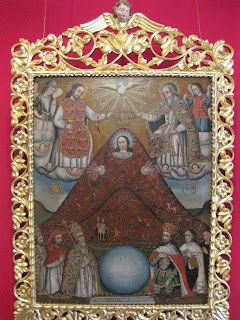Potosí was once the richest city in South America, built on the immense wealth of minerals, particularly silver, that was exploded and dug and picked out of Cerro Rico, the multicolor mountain that rises above the city. Touring a mine in Cerro Rico has become one of the principal tourist attractions there. Mike and I had a bit of a discussion about undertaking the mine tour:
His position was that these men work and their families have worked for generations under intensely difficult conditions, that they therefore must have a great pride in what they do, and that the gifts one buys for the miners during the guided tour must alleviate some of the costs of their job and the distraction of talking to tourists about it.
My position was that as relatively wealthy tourists, paying a third party to come down to the mines to gape at men doing a difficult and dangerous job, the fallout from which typically costs them their lives before age 45, and to which they can expect to attribute their sons' deaths before age 45, we must be only just endurably insulting.
We haven't come to an agreement but we did go down into La Candelaria, a mine opened in colonial times and one of the 150 and more that honeycomb Cerro Rico. There is a miners' museum at the start that has a representation of Tio, the miner's devil to whom they make offerings and who they consider to be the owner of the rock they work.




Underground we walked with mostly bent necks (and helmeted heads), sometimes crawling through muddy tunnels caked with sulfurous secretions. There was a lot of dust, to remind us that the cause of most miners' deaths is pulmonary silicosis. At two places we dropped down quite steeply on rickety ladders, and twice heard a boom and felt the rush of air as dynamite was detonated nearby. We danced back and forth across the tracks as 4 men pushed and pulled a one-ton car (according to our guide) loaded with another ton of rock past us and then reversed course to go down a capillary offshoot.
Mike did a bit of shoveling with one set of miners we met and our guide passed out our gifts: soft drinks which, according to Efrain who has worked in the mines, are the only nourishment the miners take in their 10 or more hours at work, eating being enervating and difficult in the dusty environment. Also coca leaves which many people here chew for energy. And dynamite, a staple of the profession. We bought all this at a sidewalk store on the road up to the mines; it is a built-in part of the tour. When we got back to the surface Efrain and another guide blew up dynamite for us, purchased for the purpose.







As well as the mines we toured some of the city's churches and the galleries of the Casa de la Moneda, the old mint. The Convento de San Francisco had a beautiful view from the roof, a precautionless tour that would give any safety-happy bureaucrat in the U.S. fits.










We had two lovely encounters in Potosí. As we were wandering through a non-touristed part of town a woman with her family asked us where we were from, then explained to us in rapidfire Spanish that she was a Christian, that she loved to talk (quite evident already) and that she had many friends and would have had us to her family lunch that day had we already met. After we parted from Señora Fanny she ran down the street after us to exchange phone numbers.

That evening we followed a sign that promised a restaurant and found our way into a 20-person family gathering. The people eating had some sort of relation to the owners of the restaurant; regardless they let us take over the little table in the corner. We had a great dinner and were on the point of leaving when the waitress/everyone's-apparent-cousin-or-neice asked us to stay for "un pequeño show." A guy dressed in a tuxedo was introduced and proceeded to lip synch to 6 or so songs by Luis Miguel, a Mexican heartthrob. It was silly and fun, and our host, Jaime, brought us a brandy snifter of Fanta and Campari to top everything off.




No comments:
Post a Comment